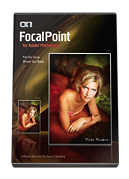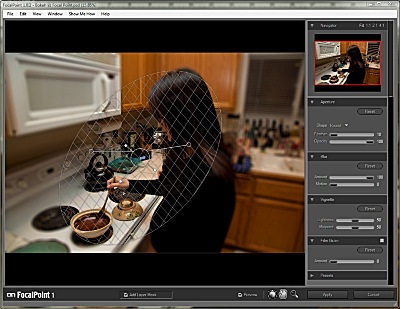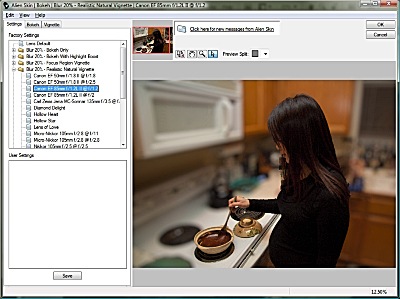Lately there seems to be a trend of trying to create that sweet bokeh you get from expensive lenses using Photoshop add-in filters. This article will compare two add-ins from two top notch companies - onOne Software and Alien Skin Software as well as Photoshop CS4's own Lens Blur filter.
onOne Software Focal Point 1.02
onOne's way of trying to simulate the sweet bokeh created by great lenses like the Canon EF 50mm f/1.2L USM or Nikon AF-S Nikkor 50mm f/1.4G is to apply a radial blur to the entire image and then let you tweak the settings in its UI as shown below using its unique "spider" control:
This control works great if you have a fairly simple oval or planar region that you want apply your blur towards, but it has holes in real world applications such as the the situation below where we want to make my lovely expectant wife the focal point and ignore my daughter and the noise in the background. In addition, using its strongest blur, still results in a blur that isn't super strong as shown in this image:
FocalPoint is easy to use and offers a fantastic UI, but its spider control doesn't yield the best results for a shot like this.
However, there is an added benefit to FocalPoint in that it offers some interesting presets for nice vignettes and the spider is great for offering control over the effect for a really slick border to your photo.
FocalPoint is included with the great product suite offered by onOne Software called Plugin Suite 4.5 which is offered at a discount for readers of this blog.
Click here to learn more about FocalPoint.
UPDATE: Click here to see my new review for 2.0.
Alien Skin Software 1.0.0.174
Alien Skin Software is known for great quality software, and pretty basic (i.e., no-frills) user-interfaces. They offer a wide variety of simulations of great lenses like the Canon EF 85mm f/1.2L II USM, and the bokeh is absolutely beautiful. Here's a view of its crude user-interface:
However, a big challenge (although some would call it a benefit) of Bokeh is that you must apply your selection of the area you wish to protect (i.e., not apply the blur to) prior to running the Bokeh filter (unless you use the focus region options). The results can be great if your selection is good, but if your selections are off (as mine was in this example which was done with a fast quick mask selection) then you'll have nasty holes without a nice feather like FocalPoint offers (at least using the preset options):
The result is that you end up with something that can be great if you take the time up front to make sure your selection is spot on. This of course, makes it not much different than applying a lens blur in Photshop itself which makes you wonder what it is you are really paying for? The answer it seems, is the magic settings that simulate some famous lenses known for fantastic bokeh.
CORRECTION (6/25/09)
When I wrote this article I made a huge mistake because I hadn’t noticed the focus region section of the Bokeh UI which allows you to use a tool similar to what Focal Point offers. While I still like Focal Point’s “spider” better, this gives this product a lot more functionality than I had originally given it credit for.

Alien Skin has decided to discontinue its discount, but you can support this blog by purchasing through this link. Your support is GREATLY appreciated!
Photoshop CS4 Lens Blur
Since Bokeh isn't much better (but it is MUCH faster) than the Lens Blur filter in terms of flexibility, I thought I'd do a quick comparison to see how it did. The settings I used were hexagon shape, a radius of 79 (a total guess) blade curvature of 14 (previously used setting) and the rest of the values were the defaults (including the Uniform distribution instead of Gaussian - which didn't have a obvious difference). Here's the result of the Photoshop version overlaid on the Bokeh version:
The net result is that it is similar, but you might not be able to crank CS4 up high enough to get the same results as Bokeh. In fact, the results look closer to what I got in FocalPoint.
Canon 50mm f/1.2L at f/1.2
Unfortunately I didn't have time to do a comparison of a single image using the real lens against the fake versions (by shooting a shot with the lens at a more narrow aperture like f/11), but just for kicks I thought I'd include a picture so you could see the bokeh of this lens. My apologies for the ugly model, but I returned this lens and purchased the more affordable Canon EF 50mm f/1.4 USM so this was the first pic I could find that I took with the 1.2 @ 1.2:
As you can see the bokeh is pretty sweet, but perhaps not as smooth and exaggerated as the one created by Bokeh.
Conclusion
When I analyze the two products together (move your mouse in and out on the image below), you quickly notice that Bokeh is using the stronger blur that really does a decent simulation of the great bokeh you'd get from a high end lens:

With that in mind, is it worth paying for the effect? Well, if you consider the cost of a typical f/1.2 lens costing over $1000 and the fact that Bokeh offers a decent simulation of several of them, it could be argued it as a good value. Then again, it is really easy to get results that aren't believable as its is more than just a good selection, but also knowing how to apply the appropriate gradient to feather the blur in the transition areas. These details can only be done by understanding what these lenses do in real life, so that leaves the user with a gap in knowledge to do an accurate job if they've never actually owned the lens.
Overall, I'd say that there's not much advantage to FocalPoint over Photoshop's Lens Blur filter, but Bokeh does offer a noticeable advantage in a much less user-friendly user-interface. Short of having the real thing, Alien Software's Bokeh seems to be the product of choice for simulating what some of the great lenses do, but if your goal is to simply use blur as an mechanism for guiding the users eye to your focal point, then Photoshop's Lens Blur filter should be sufficient for your needs at no additional cost.
Disclosure
I was provided free copies of these products and will receive a commission if you use the links in the blog. Thank you for supporting this blog by using these links and the discount codes.








8 comments:
Thanks for the review...
Hi Ron,
Thanks for your review. I just wanted to point out that Bokeh has built-in radial and planar tools, which can be used to quickly isolate a subject without using a selection mask. They can also be used to create a tilt-shift effect.
Jim White shows how to use the radial tool in this tulips video tutorial . All of the examples in this fake-model photography tutorial were also created using the radial tool.
Jim also has a baseball video tutorial that shows how to use the planar tool together with a selection mask to achieve a realistic depth-of-field result.
Thanks.
Terence Tay
Alien Skin Software
I just came across your blog and wanted to thank you. I have been trying to find a comparison between onone focal point & Alien Skin's Bokeh. After hours of surfing the net I found your blog. It is w/o question the only true side by side comparison. I found myself reading many of your other posts for another hour. I will be keeping up w/ your blog as it is very photographer friendly.
Having played around with both FocalPoint and Bokeh, there is one huge feature in FocalPoint that is sorely missing in Bokeh - the ability to paint in a mask so it's not blurred out. For complex scenes where depth of field is not a simple circular, oval, or planar, to create a realistic bokeh, you need the ability to paint in different degrees of blurring. FocalPoint has it, but the latest version 2 of Bokeh still does not. Bokeh's got some cool effects to give highlights different shapes, etc. which is missing in FocalPoint though.
Focal Point is SOO slow you might as well do it manually. I run a i7 SSD drive system with 16GB ram. It is bad programming for it to be so slow! Bokeh is fast and a MUCH cleaner finish FP leaves nasty ring around the spider. Also you have to load FP via Autmation (could be a good thing), not practical in regular plug in use. I think FP has good intentions but the speed fails it. I honestly cant see anyone make this comparison and end up likeling FOcalPoint. You should try using a file that is realistic.
Your review sounds like its in favor of FP, and that is your opinion, but you explain that in the disclaimer as you are paid by them and no longer get coupon for Bokeh. Which is a much better program.
I'm not sure what your agenda is here Anonymous, but did you really read the article? I say:
Short of having the real thing, Alien Software's Bokeh seems to be the product of choice for simulating what some of the great lenses
I honestly dont have one. But..I read the article and the follow ups, and for some reason it sounds like it favors FocalPoint. Yes You do mention the lens matching as a advantage, but in reality I dont know anyone including myself that does lens matching and leaving that set in default. pixel tweakers and anyone looking for a nice result will tweak that setting. I did read your other reviews and they are actually very helpful to new comers and even advanced shooters, and I encourage them to read on, but I cant imagine anyone sitting through a file from a 5Dm2 to load FP. What the GENIUS at Alien did(Hey send me a free copy), is he had the programming save a low res version, so you see the sim on it, then it does take time to apply it. Bingo! Done! My other agenda is that I am having less and less use for a $400+ OnOne suite I purchased(FocalPoint was one of the top2-3 reasons for purchase)..I wish to replace FP with Bokeh, Fractal and Frames is about all the use for OnOne, as Nik, and even Topaz takes care of it. I guess its normal for each company to have their "star" plugin, but they are Sooo pricey, and us "pro's" dont get academic versions as our work gets published, so imagine a solo artist shelling $500 average for each suite! and they will use 10-25% of each. My overall point is...FP is not even close to being a viable option in MOST real world usage. Thats how slow it is. So you sound like its neck and neck, or even FP having the lead, and its not. Other than that, I really do appreciate your posts and I wouldnt waste the time to post if I didn't mean to be constructive. Shoot on!
I'm aware that a lot of people need to pick and choose what add-ins they buy based on their own budget. Before I ran this blog I was the same way and I was tighter than a Nun's... well, you get the idea.
This is why I wrote this article:
http://www.ronmartblog.com/2010/12/what-plug-ins-should-i-buy.html
This was my attempt at being as clear as I could as to what my stack ranking is based on having all of these installed and how I actually find myself using them or not.
I will say that the perf problems you have with Focal Point are not normal, BUT it sounds like you have an advanced machine so I've seen a lot of software that does hardware acceleration have experiences like you have due to problems with either the driver or some issue with the software's hardware acceleration code. This can be resolved generally by contacting the software company (in this case onOne Software) and getting it sorted out. I saw this same perf issue with Nik Software's HDR Efex, but I got it resolved after getting an updated video driver on my machine.
Focal Point 2.x made some performance improvements as well (in fact the whole Perfect Suite is the most peppy version of onOne products I've seen to date).
In fact, to my knowledge all of the recent wave of onOne products actually offer multiple options to improve performance - one of which is to bypass hardware acceleration and use a screen rez version of the file just like AS does and the performance is very good.
I don't have anything against Alien Skin Software - they make good products and I have favorable reviews of Bokeh and Blow-Up. I did more recently discover that while Blow-up beat GF in my display output testing, GF was much stronger when applying its resizing to prints - especially huge prints.
Thanks for your feedback and my apologies if my response seemed a bit harsh, but I get more spam comments than valid comments so I was wondering if this was someone with a hidden agenda.
Post a Comment